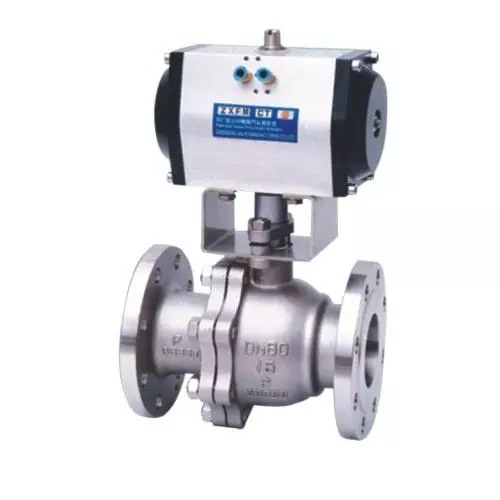A Brief Introduction of Pneumatic Ball Valves
Pneumatic ball valves develop from plug valves. Pneumatic ball valves can also be rotated 90 degrees, the same as plug valves. The difference is that ball valves use a ball as their cock. A hole exists on ball or passageway crosses through axis of ball. When ball rotating 90 degrees, both intake and outtake should show sphere in order to cut off flowing. Pneumatic ball valves can be installed at any positions of pipe. When equipped with various accessories, including solenoid values, air source treatment units, limit switch, positioner, control cabinet, pneumatic ball valves can realize local control or long distance centralized control. People can control switch of valves inside control room without attending fields, high altitude or danger zones for manual control. To a large extent, pneumatic ball valves save labor resources and time. Meanwhile they also improve security.
Advantages of pneumatic ball valves:
Pneumatic ball valves are mainly used for cutting off or connecting media inside pipe. They also can be used for regulating or controlling fluid.
1. Springs are installed between ball, stem and body, which can derive static during turning on-off.
2. Stem has reliable sealing. Packing seal of stem is not destroyed easily. Sealing ability grows with pressure of media rising.
3. Seat has good sealing and has a sealing which is made of PTFE or other elastic materials. The structure is good for sealing. Sealing ability of seat also grows with pressure of media rising.
4. Thrust bearing reduces friction torque of stem, making stem operate smoothly and smartly for a long term.
5. PTFE and other materials have good self-lubrication and less loss when grinding with ball. Nevertheless, pneumatic ball valves have long service life.
6. Bottom stem and convex on top of stem prevent stem from erupting. Convex forms metallic contact with body, ensuring sealing of stem.
7. Compared with other types of valves, ball valves have the lowest fluid resistance. Even reduced bore ball valves have fairly low fluid resistance.
Materials of pneumatic ball valves:
1. Materials of ball valves: Pneumatic ball valves are mainly made of nodular cast iron and should be indicated with grade and actual physical of chemical test data of cast iron.
2. Materials of stem: Stem should be made of stainless steel (2CR13). Stem on large diameter valves also should be embedded with stainless steel.
3. Materials of nut: Nut is made of casting aluminum brass or casting aluminum bronze. Both hardness and intensity are higher than those of stem.
4. Materials of lining: Hardness and intensity should not higher than those of stem. When soaked under water, lining cannot cause electrochemical corrosion with stem and body.

